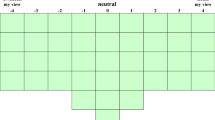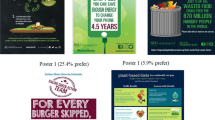Abstract
To measure attitudes toward environmental issues, interior design students responded to a four-part survey: demographics, ecology, sustainability, and comments. The ecology section was composed of modifications of questions from the New Ecological Paradigm Scale (Dunlap et al. Journal of Environmental Education, 9:10–19, 2000). The researchers composed the items in the sustainable section to reflect perceptions related to the use of sustainable products and solutions in interior design scenarios. Although the ecology and sustainability survey results exhibited great variability, responses to individual items mostly averaged towards the more pro-environmental and pro-sustainability sides of the scales. While average scores on the ecology section of the survey showed the respondents as a group to be moderately pro-environmental, most items revealed a considerable amount of undecided ratings and quite a few students who perceived the environment to be somewhat invincible. The data also indicated a discrepancy between what students think they know (sustainability section) and what the students actually reveal in their open-ended answers (comments section). The survey results imply that educators, who themselves are likely to be pro-environment, cannot merely assume that their students share the same values and attitudes. Beginning instruction with explanations and examples of sustainable methods and products will not be sufficient to communicate the delicate balance between Human use of resources and Nature’s ability to replenish. Design educators need to set the stage for sustainability rather than just assume that students will embrace the concept. Hopefully, more research studies will inspire others to evaluate their own students’ feelings about the environment.
Similar content being viewed by others
Abbreviations
- NAHB:
-
National Association of Home Builders
- NEP:
-
New Ecological Paradigm Scale
- IDEC:
-
Interior Design Educators Council
- c2c:
-
Cradle-to-cradle
References
Cradle to Cradle Task Force (2005, March). Endorsing the c2c design paradigm (Task Force proposal presented at the annual business meeting of the Interior Design Educators Council, Savannah, GA).
Dunlap, R. E., & Van Liere, K. D. (1978). The “New Environmental Paradigm”: A proposed measuring instrument and preliminary results. Journal of Environmental Education, 9, 10–19.
Dunlap, R. E., Van Liere, K. D., Mertig, A. G., & Jones, R. E. (2000). Measuring endorsement of the new ecological paradigm: A revised NEP scale. Journal of Social Issues, 56(3), 425–444.
Elliott, J. (2004, March). Teaching sustainability to tomorrow’s interior designers Metropolis. Retrieved May 23, 2007, from http://www.metropolismag.com/cda/story.php?artid=58
Elshof, L. (2006). Productivism and the product paradigm in technological education. Journal of Technology Education, 17(2), 18–32.
Ewert, A., & Baker, D. (2001). Standing for where you sit: An exploratory analysis of the relationship between academic major and environment beliefs. Environment and Behavior, 33, 687–707.
Foundation for Interior Design Education Research (1996). The future of interior design. Grand Rapids, MI: Author.
Foundation for Educational Research in Interior Design (2002). Accreditation manual. Grand Rapids, MI: Author.
Gay, L. R., & Airasian, P. (2003). Educational research: Competencies for analysis and application. Upper Saddle River, NJ: Merrill Prentice Hall.
Gore, A. (2006). An inconvenient truth. New York, NY: Rodale.
International Institute for Sustainable Development (2007). What is sustainable development? Environmental, economic and social well-being for today and tomorrow. Retrieved May 25, 2007, from http://www.iisd.org/sd/
La Trobe, H. L., & Acott, T. G. (2000). A modified NEP/DSP environmental scale. Journal of Environmental Education, 32(1), 12–21.
McDonough, W. (2004). Teaching design that goes from cradle to cradle [Electronic version]. Chronicle of Higher Education, 50.
McDonough, W., & Braungart, M. (2002). Cradle to cradle. New York, NY: North Point Press.
McKeown, R. (2002). Challenges and barriers to education for sustainable development. Retrieved May 23, 2007, from http://www.esdtoolkit.org/discussion/Challenges.htm
National Association of Home Builders (2004). Housing facts, figures, and trends. Washington DC. Retrieved February 5, 2005, from http://www.nahb.org/fileUpload_details.aspx?contentTypeID=7&contentID=20
National Association of Home Builders (2005). Building a balance: Solid waste disposal. Retrieved April 5, 2005, from http://www.nahb.org/generic.aspx?genericContentID=379
Sustainability Reporting Program (2000). A brief history of sustainable development. Retrieved on November 7, 2004 from http://www.sustreport.org/background/history.html
United Nations (2004). Chapter 36: Promoting education, public awareness and training. Agenda 21. Retrieved May 23, 2007, from http://www.un.org/esa/sustdev/documents/agenda21/english/agenda21chapter36.htm
World Commission on Environment and Development (1987). Our common future. Oxford: Oxford University Press.
Author information
Authors and Affiliations
Corresponding author
Rights and permissions
About this article
Cite this article
Ruff, C.L., Olson, M.A. The attitudes of interior design students towards sustainability. Int J Technol Des Educ 19, 67–77 (2009). https://doi.org/10.1007/s10798-007-9038-0
Received:
Accepted:
Published:
Issue Date:
DOI: https://doi.org/10.1007/s10798-007-9038-0




